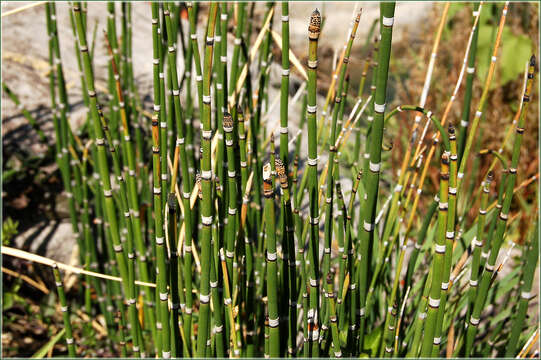Common scouring rush (native)

Description:
Typically referred to as simply Equisetum hyemale L. but plants in North America are considered to belong to a separate subspecies from those in Europe, and are treated as Equisetum hyemale L. subsp. affine (Engelm.) Calder & Taylor. Even within the "affine" group, morphological differences have been observed in plants in southern and central/western areas of North America compared to plants in the "far west" which have led in the past to other published names, but which currently are included within this complex (Equisetum robustum var. affine and E . hyemale var. californicum are examples).Note the pointed (apiculate) cones and the gray-ash as well as the adjoining narrower black bands on the robust stems. Our tallest Horsetail. Known also as Common scouringrush. Pioneers perhaps confused it as looking rush-like and the plants were used to clean/scour pots and pans and such because of its silica content. "Scouringrush" (or with a space or a hyphen) is in fact commonly used with at least three other species of Equisetum. See FNA's use of the same common name at www.efloras.org/florataxon.aspx?flora_id=1&taxon_id=2.... For more clarifying use on the common name as used in the United States, see www.illinoiswildflowers.info/grasses/plants/scouring_rush....Equisetum hyemale subsp. hyemale occurs in Europe/Asia/China and it not the same taxa, at least a presently understood.This portion of the creek did not exist until relatively recently when it was diverted and these plants have managed to take advantage of this new habitat within the past two years.Sept. 14, 2012, Salt Lake County, Utah, along Big Cottonwood Creek at approx. 4,380 ft. elev.
Included On The Following Pages:
- Life (creatures)
- Cellular (cellular organisms)
- Eukaryota (eukaryotes)
- Archaeplastida (plants)
- Chloroplastida (green plants)
- Streptophyta
- Embryophytes
- Tracheophyta (ferns)
- Polypodiopsida
- Equisetales
- Equisetaceae (horsetails)
- Equisetum (horsetail)
- Equisetum hyemale (Common Scouring-Rush)
- Equisetum hyemale affine (scouring rush)
This image is not featured in any collections.
Source Information
- license
- cc-by-nc-sa
- copyright
- Tony Frates
- photographer
- Tony Frates
- original
- original media file
- visit source
- partner site
- Flickr Group
- ID


